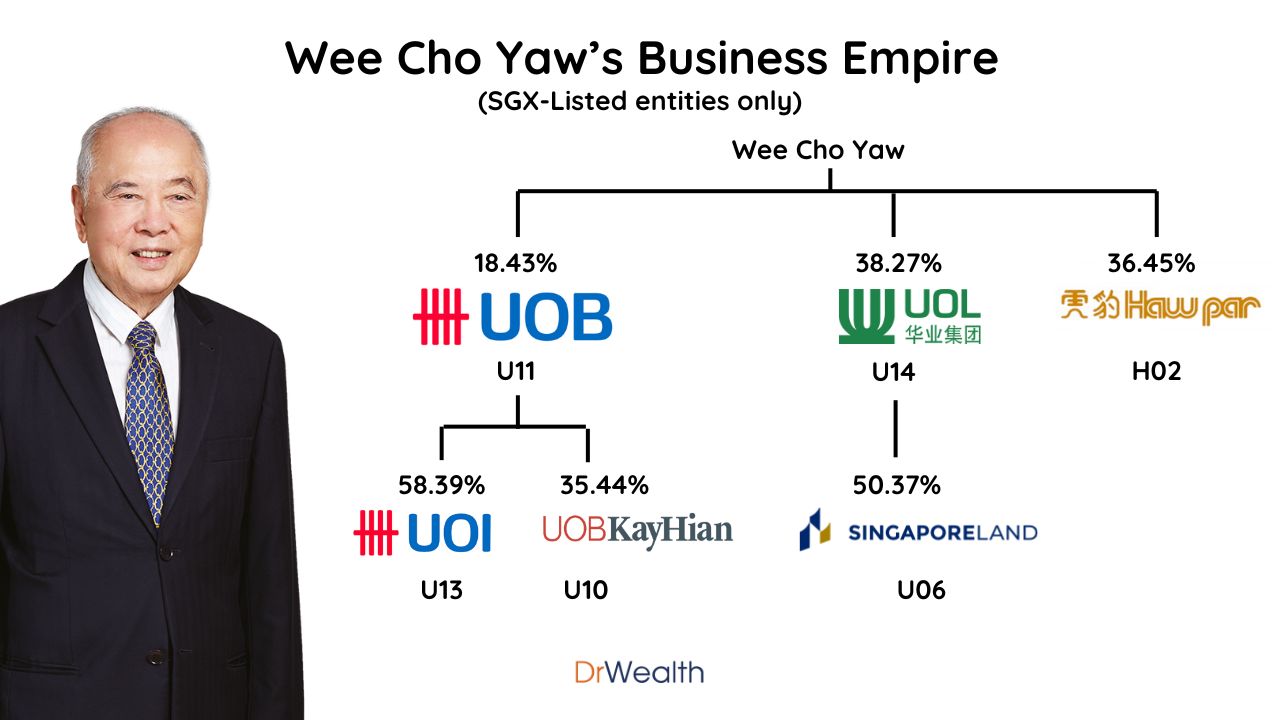Wee Cho Yaw has passed away at the age of 95, and an outpouring of condolences has been observed across the press and social media. This is attributable to his pivotal role in shaping Singapore’s banking industry.
While most Singaporeans associate him with UOB, the business empire he established extended far beyond banking, encompassing real estate, hotels, and even Tiger Balm. In this article, we aim to dissect his extensive empire.
Overview
Below is an overview of his ownership stakes in various companies listed on the SGX. He held stakes in six listed companies, some directly and others indirectly through different companies. It’s worth noting that his empire could be even more extensive if we were to include private companies; however, that discussion is beyond the scope of this article.

UOB + UOI + UOB Kay Hian
UOB stands as the crown jewel among his assets, being the third-largest listed company in Singapore by market capitalization.
The bank was founded by Wee Cho Yaw’s father, Wee Kheng Chiang, in 1935, originally under the name United Chinese Bank (UCB). In 1960, Wee Cho Yaw succeeded his father as managing director, and the bank was renamed UOB in 1965.
Under Wee Cho Yaw’s leadership, UOB expanded through a series of strategic acquisitions:
- 1971: Chung Khiaw Bank
- 1973: Lee Wah Bank
- 1984: Far Eastern Bank
- 1999: Westmont Bank, Radanasin Bank
- 2001: OUB
The acquisition of OUB, the largest among them, occurred during a period of consolidation among local banks to better compete against foreign entrants, as Singapore liberalized its banking sector.
UOB’s successful bid for OUB at S$10 billion surpassed DBS’s S$9.4 billion hostile takeover offer, marking it not only as a financial triumph but also as a friendlier approach towards acquisition.
This consolidation effectively reshaped Singapore’s local banking landscape into the ‘big three’ as it stands today.
According to its FY2022 annual report, UOB has numerous subsidiaries, with only UOI listed. UOI, a general insurance and underwriting company, sees UOB holding a 58% stake.

UOB Kay Hian, though not a direct subsidiary, is considered an associate of UOB. It stands as one of Singapore’s largest local stockbroking firms, established in 2000 through the merger of UOB Securities and Kay Hian. Among its subsidiaries, UOB Kay Hian Securities (Thailand) Public Company Limited is listed on the Stock Exchange of Thailand (SET), with UOB Kay Hian holding a 70.7% stake.
UOL
In the early 2000s, banks were mandated to divest non-core assets, including their property holdings. For instance, DBS spun out DBS Land and merged it with Pidemco to create CapitaLand. Similarly, UOL was separated from UOB, and UOB had to divest OUE (a property company that was part of OUB) to the Lippo Group.
UOL became a part of Wee Cho Yaw’s expansion strategy when UOB acquired Faber Union in 1975 and subsequently renamed it UOL. Following the same ambitious trajectory as in banking, Wee continued to acquire numerous property companies over the years, even after UOL was operated independently from the bank:
- 2002: Parkroyal
- 2007: Pan Pacific Hotels and Resorts
- 2018: Singapore Land Group (previously UIC)
Together, UOL and Singapore Land Group boast a portfolio of prime real estate assets in Singapore:

This portfolio, meticulously assembled over decades, witnessed Wee Cho Yaw defending his interests against significant challenges, including a takeover attempt by Temasek Holdings for UOL in 2004 and a control dispute over UIC against Philippine billionaire John Gokongwei Jr.
Haw Par
Haw Par Corporation, renowned for its Tiger Balm ointment, dates back to 1870. Wee Cho Yaw joined as a director in 1975 after the government intervened to revitalize the company following asset stripping by British investment firm Slater Walker.
Beyond the iconic Tiger Balm, Haw Par also operates Underwater World Pattaya in Thailand and holds investments in properties and stocks. It owns four properties—three buildings in Singapore and one in Malaysia.

These properties, recorded at a cost of $50 million, have a current valuation of $217 million, over four times their book value.

Considering these valuation figures, Haw Par’s book value would rise to $3.8 billion, significantly above its market capitalization of $2.1 billion.
Yet, the true gems in Haw Par’s asset portfolio are its stakes in 74,850,539 UOB and 72,044,768 UOL shares, valued at $2.8 billion.

Despite its substantial assets, Haw Par has been perpetually undervalued, lacking in business growth or significant events to unlock value. One way to unlock value is to sell the UOB and UOL stakes, and distribute substantial dividends to Haw Par shareholders.
Succession
The concern with the passing of a wealthy and influential patriarch or matriarch often revolves around the potential for family members to contest the assets. While it’s not suggested that this is the case for the Wee family— it’s possible that Wee Cho Yaw meticulously planned for succession, ensuring that family relations remain amicable.
Indeed, Wee Cho Yaw had, for many years prior to his passing, transitioned to an advisory role, entrusting the operation of the various businesses to his children. His sons have been actively involved, either serving as CEO or Managing Director of the business units, or taking on the role of chairperson. This arrangement suggests a continuity of leadership even after Wee’s passing.

Wee Cho Yaw served as a pivotal link between the pioneering generation of business leaders in Singapore and the contemporary business landscape. His strategic acquisitions, including that of Lien Ying Chow’s OUB and the revitalization of Aw Boon Haw’s Haw Par legacy, stand as testaments to his significant achievements. It is time for the baton to be passed to the next generation.

